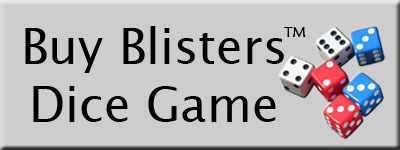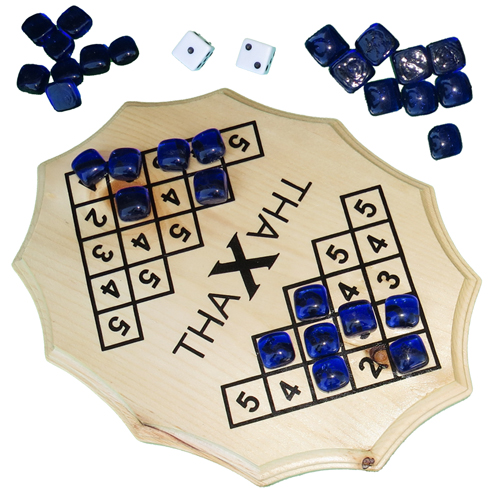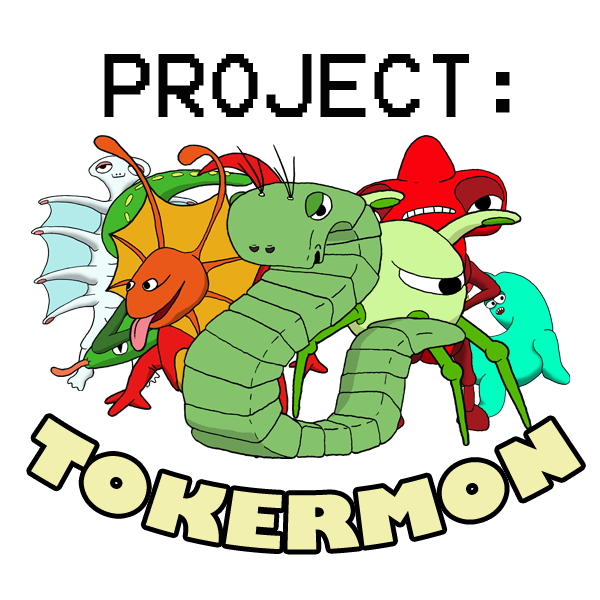Blisters™ is a simple dice game for two or more players. When learning the rules for the first time, roll the dice and see how your roll fits with these game instructions. The rules may seem complicated at first but you’ll soon see how simple they really are when you’re playing the game.
The object of the game is to control the dice and accumulate points toward a goal score. Since this game was invented during a six month hiking expedition, the goal score is usually a hiking trail’s length. We “hike” the Appalachian Trail most often when we play, a goal of 2,145 miles!
Playing: The game is played with six dice, three pair of different colors. (Your dice colors may vary from these instructions.) Play is based on matching dice. The player rolls the dice, attempting to match numbers and accumulate points. Any dice that match are called scoring dice. When the number of scoring dice is two or four (a pair, two pair or four of a kind), the player has the option of rolling the remaining unscoring dice or end that turn, adding any points to their game score total. If the number of scoring dice is uneven (three and five of a kind or a full house), the player must roll the remaining unscoring dice. When the player rolls the remaining dice, they’ll either roll more scoring dice or get “Blisters”. Whenever the player fails to roll scoring dice, this is called “Blisters” and the player loses any points from that turn.
Scoring: Any dice with matching numbers are the scoring dice. If the numbers and the colors match, the score is ten times the number on one of those dice. If the numbers match but the colors do not, the score is the sum of the dice. For example; two red fives, a white four, a blue four, a blue two and a white three have been rolled. The two fives are the same color and are worth ten times the number on one of the dice or 50 points. (10 X 5) The two different color fours are worth their sum or 8 points. (4 + 4) The blue two and the white three do not match any other dice so they are worth nothing. In this example, the player has the option of rolling the unscoring dice (the two and the three) or ending this turn and adding the 58 points to their game score total.
The player continues to control the dice until:
- The total number of scoring dice is two or four and he/she chooses to end this turn, adding the points to the game score total.
- The player fails to roll any scoring dice. (Blisters)
- The player has 6 sixes. We’ll get to this rule later.
If the player scores with all six of the dice during play, that player must continue, adding any points gained so far to the turn total and rolling ALL six of the dice again. It is important to recognize the difference between the game score and the turn score. The turn score can be lost when the player gets Blisters during that turn. The game score cannot be lost when the player gets Blisters.
IMPORTANT: When the player achieves or exceeds the goal score, each of the other players has one more turn to beat that player’s score. The one with the most points after all the players have taken their last turn is the winner.
Another rule to remember; If any player gets six sixes at any time during the game, that player has lost the game. This is called “bailing”. You don’t have to roll all six at once to lose the game, more often you’ll find you’re forced into rolling to lose the game or just to lose the turn (Blisters). Of course, if there are more than two players, the remaining “hikers” continue the game.

Since the object of the game is to control the dice (or “walking”, in the game lingo), the player can choose to roll whenever they have the opportunity. Taking that risk is how to get some big points (or “miles”). You can play it safe and inch your way toward the goal by stopping as soon as the dice allow. (a pair, two pair or four of a kind) Turns will end up with Blisters more often when going for those “big miles”.
You’ll probably want to keep track of the score with a pencil and paper, however, using your memory can be fun as well as challenging. There’s a cool Blisters pencil included (as well as a snazzy pouch) when you buy the Channel Craft version of the game.
Sometimes turns last forever, other times they are over on the first roll (1,2,3,4,5,6! We call this a zero day”). You’ll notice patterns in scoring and gameplay, some turns may even amaze you. You can reach any goal score you choose in one turn if the luck of the dice is with you. I’ve seen a turn over 2000 miles! I find it easier to tally up the points when I’ve used all the dice. This makes it easier to keep track of the turn’s total.
You can’t re-roll any dice that are scoring. Once they match numbers with another die, they must remain, unless of course, you score using all the dice and must roll all six dice again.
Here is a sample turn:

FIRST ROLL:
The player rolls 3 fives in their first roll of ALL the dice, an uneven number of scoring dice. The player must roll the remaining unscoring dice. The red one, the red three and the blue four are the unscoring dice in this example and must be re-rolled.

SECOND ROLL:
The player now has the 3 fives from the first roll and the newly rolled pair of twos. Still an uneven number of scoring dice so the player must roll the remaining red three. (game lingo: still walking)

THIRD ROLL:
Another two is rolled. All the dice are now scoring dice, so the score is tallied before all six dice are rolled again. The total so far is 77. (2X10+2=22 added to 5X10+5=55, totaling 77. Get it…?). Remember, dice of the same color are worth ten times one of those dice, different colors are just added together. The player used all the dice, however, and must roll all six again (still “walking”). Remember that turn total! (turn total=77)

FOURTH ROLL:
The player has rolled 3 fours, an uneven number, and must roll the remaining non-scoring dice. (the red one, the red two and the blue five)

FIFTH ROLL:
Another four! The number of scoring dice is now an even number (4). The player now has the option of rolling the remaining non-scoring dice (the red 3 and the red 5), hoping to continue to add to their score, or end this turn and add the entire turn’s total to the game score total. Wisely, the player chooses to end this turn with a total of 157 “miles”. (4X10=40 plus another 4X10=40 plus the previous roll of 77) 157 is now the game score total and cannot be lost.

Here is another sample turn:

FIRST ROLL
2 twos and 3 threes are rolled. Since this is an uneven number scoring dice, the remaining non-scoring blue five must be rolled. (Game lingo: the player has got to “walk”)

SECOND ROLL:
The player rolls a four which doesn’t match any of the other dice and is unscoring. This player has got BLISTERS and their turn is now over.
Still Stumped…? Watch this video tutorial by the creator of Blisters™, Tim Novak:
See… Blisters™ Dice Game is EASY to play… get your dice and have fun!
Blisters™ Rules Copyright 1987 © Tim A Novak








